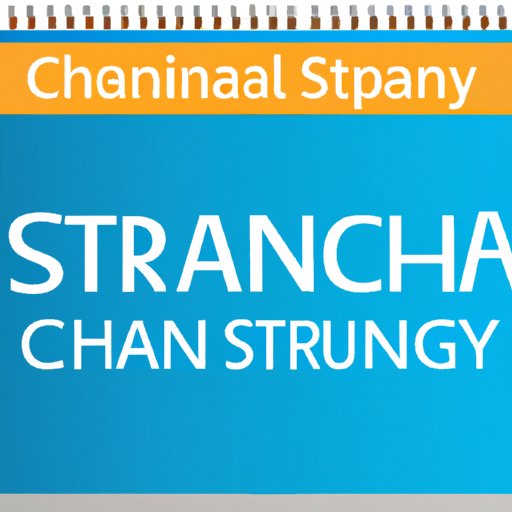Introduction
Supply chain finance (SCF) is a powerful tool for companies of all sizes to efficiently manage their cash flow and optimize their financial performance. By leveraging SCF, companies can reduce their risk exposure, increase their efficiency, and take advantage of new opportunities in the global marketplace. In this article, we will explore what supply chain finance is, discuss its different types, examine the advantages and challenges, provide an overview of the global market, and outline how companies can leverage this tool to improve their financial performance.

A Comprehensive Guide to Supply Chain Finance
Before delving into the specifics of supply chain finance, it is important to understand the basics. According to the International Chamber of Commerce (ICC), SCF “is a set of solutions that optimise working capital by providing suppliers with earlier payment at lower cost and buyers with extended payment terms”.1 In other words, SCF is a way for companies to manage their cash flow by providing earlier payments to their suppliers while allowing them to extend payment terms to their buyers.
There are several different types of SCF, each offering different benefits and challenges. The most common types are invoice discounting, factoring, reverse factoring, and dynamic discounting. Invoice discounting involves the sale of invoices to a third party, usually a bank or other financial institution, at a discounted rate. Factoring is similar to invoice discounting, but instead of selling the invoices, the seller agrees to a fixed rate of interest over a specified period of time. Reverse factoring is when a buyer pays its supplier directly, rather than through a third party. Finally, dynamic discounting is when a supplier offers discounts to its buyers in exchange for early payment.
Exploring the Benefits of Supply Chain Finance
The benefits of SCF are numerous and can help companies of all sizes to improve their financial performance. One of the primary benefits of SCF is improved cash flow. By providing earlier payments to suppliers and extending payment terms to buyers, companies can better manage their cash flow and ensure that they have sufficient funds available to pay their bills on time. This can also help to reduce the risk of late payments, which can result in penalties and other costs.
Another benefit of SCF is the reduced risk associated with the process. By using a third-party provider to facilitate payments, companies can reduce the risk of fraud and non-payment, which can save them money in the long run. Additionally, SCF can also reduce the risk associated with currency fluctuations, since payments are made in the local currency, rather than a foreign one.
Finally, SCF can help to increase efficiency by streamlining the payment process. By automating the payment process, companies can reduce the time and resources needed to manage payments, leading to increased efficiency and cost savings.
How Companies Can Leverage Supply Chain Finance
In order to effectively leverage SCF, companies must first establish a strategic plan. This plan should include an analysis of the current state of the company’s supply chain, an evaluation of the potential risks and rewards associated with SCF, and an understanding of the types of financing options available. Once this plan is in place, companies can then begin to identify key areas for improvement, such as optimizing payment terms, reducing transaction costs, and increasing operational efficiency.
Once these areas have been identified, companies can then begin to utilize technology to enhance their performance. For example, they can use software to automate processes such as invoice processing and payment reconciliation. This can help to reduce manual errors, improve accuracy, and reduce the time required to complete transactions. Additionally, companies can use analytics to gain insights into their supply chain, enabling them to make more informed decisions regarding their operations.

The Role of Technology in Supply Chain Finance
Technology plays a vital role in the success of SCF. Automation of processes such as invoice processing and payment reconciliation can help to reduce manual errors, improve accuracy, and reduce the time required to complete transactions. Additionally, technology can be used to enhance data collection and analysis, providing companies with greater visibility into their supply chain and enabling them to make more informed decisions. Finally, technology can also help to ensure compliance with applicable regulations, as well as improve security measures to protect sensitive data.

An Overview of the Global Supply Chain Finance Market
The global SCF market is expected to grow significantly in the coming years. According to a 2019 report from Grand View Research, the global supply chain finance market was valued at $17.6 billion in 2018 and is projected to reach $67.7 billion by 2026, growing at a CAGR of 18.9%.2 This growth is being driven by a number of factors, including increased demand for efficient supply chain management, advances in technology, and growing awareness of the benefits of SCF.
The report also highlights some of the key trends and drivers in the global SCF market. These include the emergence of cloud-based platforms, the increasing adoption of automated solutions, and the growth of the e-commerce sector. Additionally, the report notes that the rising demand for real-time visibility into supply chains is another key trend driving the growth of the SCF market.
Conclusion
In conclusion, supply chain finance is a powerful tool for companies of all sizes to efficiently manage their cash flow and optimize their financial performance. By leveraging SCF, companies can reduce their risk exposure, increase their efficiency, and take advantage of new opportunities in the global marketplace. Additionally, the global SCF market is expected to experience significant growth in the coming years, driven by advances in technology and the increasing demand for efficient supply chain management.
By understanding the basics of SCF, examining the different types of financing available, and exploring the benefits and challenges associated with the process, companies can leverage this tool to improve their financial performance. By establishing a strategic plan, identifying key areas for improvement, and utilizing technology to enhance performance, companies can take full advantage of the benefits of SCF and position themselves for success in the global marketplace.
1International Chamber of Commerce. (2018). What is Supply Chain Finance? Retrieved from: https://www.iccwbo.org/policy/finance-trade/what-is-supply-chain-finance/
2Grand View Research. (2019). Supply Chain Finance Market Size, Share & Trends Analysis Report By Solution (Invoice Discounting, Reverse Factoring, Dynamic Discounting, Others), By End-use Industry (Retail, IT & Telecommunications, Manufacturing, Healthcare, Others), And Segment Forecasts, 2019 – 2026. Retrieved from: https://www.grandviewresearch.
(Note: Is this article not meeting your expectations? Do you have knowledge or insights to share? Unlock new opportunities and expand your reach by joining our authors team. Click Registration to join us and share your expertise with our readers.)
